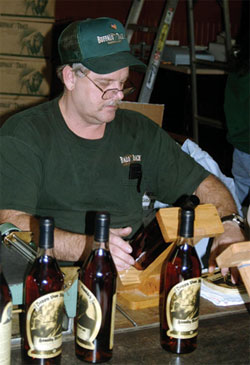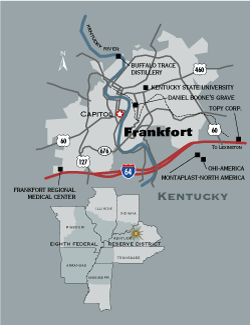Community Profile: Frankfort, Ky., Capitalizes on History, Variety
Frankfort, although small, is a multidimensional city. Bourbon, a revitalized downtown, state government and manufacturing have put their stamp on the economy.
Herds of buffalo once stampeded through present-day Frankfort, creating quite a thunder along the banks of the meandering Kentucky River. Historians say that these burly animals traveled on an ancient "trace."
Signs of the buffalo still exist in Frankfort, most visibly the buffalo painted on the water tower 170 feet above the Buffalo Trace Distillery, the oldest continuously operated distillery in the United States.
"Schoolchildren tour our facility, and some people might think that is strange because this is a distillery," says Buffalo Trace spokeswoman Angela Traver. "Bourbon, though, is such an important part of the heritage of Kentucky."
There's much more to Frankfort than buffalo and bourbon, however. The city of 27,408 serves as the state capital. It's also home to a number of manufacturers serving the auto industry, which is becoming increasingly important in this part of the country. And, like many other small towns with a healthy mix of white- and blue-collar workers, subdivisions are springing up on the outskirts of town while preservationists are working to restore downtown to its Mayberry-esque days.
The combination makes Frankfort an attractive place for many people and businesses. It's among the Top 20 small cities in Kevin Heubusch's "The New Rating Guide to Life in America's Small Cities." The author rates Frankfort the No. 2 micropolitan city in the South, after Rome, Ga. No wonder the population has grown about 1,000 over the past five years.
Ann Wingrove, who owns two businesses in downtown, probably speaks for many when she says, "This is a wonderful place to live and to raise children and a great place for walking. The qualities that make it a great place to live also make it a great place to do business. You know the people wherever you go."
Just north of downtown is the Buffalo Trace Distillery, one of the larger manufacturers in town. Local records indicate that settlers began making bourbon on this 110-acre site in 1787. (Speaking of settlers, Daniel Boone's grave is in Frankfort.) Over the years, distillers found that the rich, limestone-filtered water from the Kentucky River yielded a fine whiskey. Seven other distillers still operate in this central part of the state, known in the industry as "The Bourbon Trail."
In the 1950s, the distillery employed more than 1,000 people. By the early 1980s, that number had dwindled to 50. People wanted to drink wine, not bourbon.
"We were dangerously close to closing our doors," Traver says.
The distillery has made a comeback, though. In 1992, it was bought by the Sazerac Co. of New Orleans, which owns other distilleries around the country.
Sazerac has invested money to refurbish the company grounds, add new products and increase advertising. In 1999, Sazerac changed the company name from George T. Stagg to Buffalo Trace. The distillery has developed a reputation for its "boutique" bourbons. It is the only U.S. distilling company to be designated as International Distiller of the Year, an award given out since 1997 by Malt Advocate magazine. Today, the company employs 245.
Many of the larger manufacturers in Frankfort serve the auto industry. For example, there's the TOPY Corp., a Japanese-based company. Its Frankfort plant was opened in 1985. The 595 workers build steel and aluminum wheels for passenger cars and trucks. Despite the normal ups and downs of the national economy, TOPY has never had a layoff in Frankfort. The plant has been expanded a dozen times in 19 years.

At Buffalo Trace Distillery, a worker inspects the wax seal that has just been applied to the bottles.

At TOPY Corp., wheels are made for cars and trucks.
Following TOPY to the Frankfort area have been two other auto-related businesses: Ohi-America, a Japanese firm that produces automobile brakes and employs 425, and Montaplast-North America, a German company that employs 550 in the manufacture of hubcaps here.
"I'd like to think that the success of TOPY has encouraged other companies to relocate to Frankfort," says Samuel Amburgey, a TOPY spokesman.
There has, in fact, been significant expansion in overall manufacturing activity following TOPY's arrival. The Capital Community Economic/Industrial Development Authority, for example, reports that it has assisted in expanding 10 companies and in attracting 12 new manufacturers to Frankfort. These firms account for 1,774 new jobs and $32 million in additional payroll.
Bruce Brooks, executive vice president of Farmers Bank in Frankfort, a 154-year-old lending institution, says that he is eager to see more new industry come to Frankfort.
"I hesitate to use the word 'stagnant,' but there really has not been a lot going on in the last year or so in Frankfort in terms of new industry," Brooks said. "I'm encouraged, though, as far as the long term goes. I think people like to do business here because of the quality of life and because of our proximity to major highways and population centers." The city is located within one day's drive of 65 percent of the U.S. population.
Although manufacturing is important to Frankfort, the biggest shadow in town is cast by state government. In Frankfort and surrounding Franklin County, there are more than 11,000 state government employees, representing 42 percent of the workforce in the county.
The stability of government work helps keep the unemployment rate low, says Phil Kerrick, director of Capital Community Economic/Industrial Development Authority. He adds that the government jobs pay better than most. The average annual salary for a state government worker in Franklin County is more than $42,000. Other employers pay an average of about $28,000.
White collar work extends beyond the Capitol. Higher education is important in the area. Twenty-three colleges and technical schools are within 60 miles. In Frankfort itself is Kentucky State University. Its 203-acre research and demonstration farm is busy helping family farmers find alternative crops to tobacco.
No matter who the worker is, he or she is probably seeing increasing promotion for downtown Frankfort. Various booster groups are working hard to spruce up the area to turn it into a destination not only for tourists but residents. Historic homes, gardens and a bridge in the area have been restored. The owners of 27 buildings have taken part in a façade-improvement program. An array of restaurants and antique, furniture and apparel shops can be found in the historic, Victorian-style buildings that have already been fixed up.
"There are a great number of people who get it and want to see progress in the downtown area," says Sheila White, executive director of Downtown Frankfort.
Although downtown restaurants draw good lunch crowds, the streets and businesses are not so lively after 5 p.m. Most state employees head straight home after work. To slow down the quick exodus, Downtown Frankfort is sponsoring more and more night-time events, such as an annual candlelight tour during the holidays and a pumpkin festival in autumn.
Brooks, the banker, hopes that Frankfort remains committed to building a vibrant downtown, one that attracts visitors from morning until late at night. If that happens, a different kind of thundering herd will soon be roaming through town.

Frankfort, Ky.
| BY THE NUMBERS | ||
|---|---|---|
| Population | ||
| Frankfort: | 27,408 (2003) | |
| Franklin County: | 48,051 (2003) | |
| Labor Force | ||
| Frankfort: | 14,612 (October 2004) | |
| Franklin County: | 24,849 (October 2004) | |
| Unemployment Rate | ||
| Frankfort: | 3.7 (October 2004) | |
| Franklin County: | 3.1 (October 2004) | |
| Per Capita Personal Income | ||
| Franklin County: | $28,481 (2002) | |
| Top Five Employers | ||
| State Government (in county) | 11,186 | |
| Public Schools | 800 | |
| Frankfort Regional Medical Center | 650 | |
| TOPY Corp. | 595 | |
| Kentucky State University | 570 | |
Views expressed in Regional Economist are not necessarily those of the St. Louis Fed or Federal Reserve System.
For the latest insights from our economists and other St. Louis Fed experts, visit On the Economy and subscribe.
Email Us

